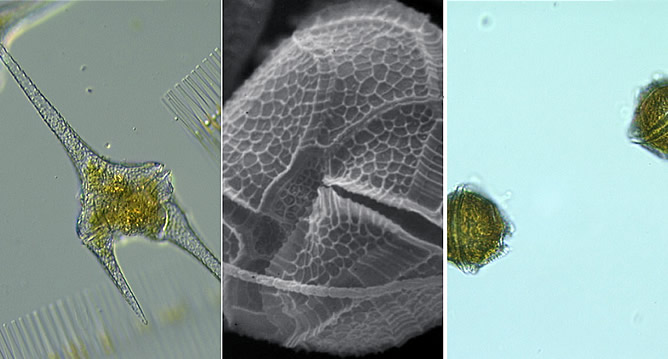| Cell | Chlorophyll | Pigments | Membranes | Thylakoids | Storage | Covering | Flagella |
|---|---|---|---|---|---|---|---|
| Eukaryotic | a, c1, and c2 | Peridinin | 3 | 3 | starch and lipids | cellulose plates | 2 unequal |

| Michael Gretz, Jason Oyadomari | Public Domain | Michael Gretz, Jason Oyadomari |
Dinoflagellates are a group of organisms that have a cell covering of characteristic rigid plates.
Most dinoflagellates are single-celled flagellates. The cells are not covered by a typical cell wall, but a “theca” that lies under the membrane of the cell. This theca is composed of rigid, distinct plates. Because of these rigid plates, many of the species are called “armored”. The armor is distinct and used to identify species, with strange and beautiful forms of armor for each species. In fact, the rigid plates protect the dinoflagellates from being eaten by zooplankton. Dinoflagellates photosynthesize using chlorophylls a and c1 or c2. They also contain accessory pigment molecules of peridinin or fucuxanthin, which may appear red in color. In high numbers, dinoflagellates can cause entire shorelines to turn red. The “red tides” are due to blooms of dinoflagellates in near shore habitats. A few species may also produce toxins, which impact the nervous systems of fish and higher animals (including humans). Paralytic shellfish poisoning is the result of dinoflagellate toxins accumulated in filtering feeding invertebrates. However, most species are not harmful, especially those species that live in freshwater. Dinoflagellates store food in the form of starch. Starch is a kind of sugar, and is stored for times when light for photosynthesis is limited. Dinoflagellates live mostly in marine habitats (about 90% of species) with a smaller number of species in freshwaters. Cells live alone, or in colonies or filaments.
Structure
The theca of dinoflagellates surrounds the cell and is composed of a number of cellulose plates. Cellulose is a carbohydrate, and same the tough fiber that makes up wood, cotton, paper and other plant-derived structures. One group of dinoflagellates, the Dinomastigota, contains a groove, or sulcus, in the theca that contains a flagellum (undulipodium). A second undulipodium lies at a right angle. As a result, when the cell uses the undulipodia to swim through the water, the cell spins and whirls. Stinging cells (trichocysts) are found under the cell membrane of many species. These trichocysts are able to sting prey so that they can be eaten.
Dinoflagellates in Rocky Mountain Lakes
Dinoflagellates are found in lakes and ponds of the Rocky Mountains. Peridinium is one of the Dinomastigota, and several species have been reported in alpine lakes.
10 taxa shown below, 6 of which appear in at least one sample.
| Name | Basionym | Synonyms | Lakes | Samples | Region* | ID |
|---|---|---|---|---|---|---|
| Glenodinium sp. | 1 | 1 | RMNP, | 8010 | ||
| Peridinium bipes var. travectum | 2 | 5 | RMNP, | 8001 | ||
| Peridinium cinctum | 0 | 0 | 8002 | |||
| Peridinium inconspicua | 2 | 17 | RMNP, | 8003 | ||
| Peridinium pusillum | 0 | 0 | 8004 | |||
| Peridinium pygmaeum | 0 | 0 | 8005 | |||
| Peridinium sp. | 1 | 10 | RMNP, | 8006 | ||
| Peridinum, cyst of | 0 | 0 | 8007 | |||
| Pyrrophyte sp. | 1 | 3 | SLW, | 8009 | ||
| Zoospores | 1 | 3 | RMNP, | 8008 |
Region:
RMNP = Rocky Mountain National Park, CO
SLW = Silver Lakes Watershed, CO
Representative images missing for: Glenodinium sp. | Peridinium bipes var. travectum | Peridinium cinctum | Peridinium inconspicua | Peridinium pusillum | Peridinium pygmaeum | Peridinium sp. | Peridinum, cyst of | Pyrrophyte sp. | Zoospores |

